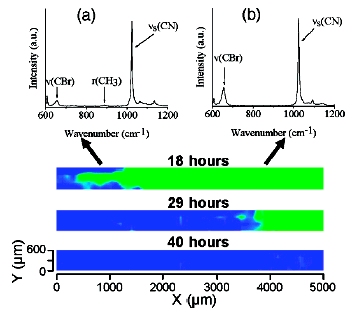Molecular
Transport in nanocapillary
Confocal
Raman microspectrometry has been applied successfully
as an in situ probe of the transport of guest molecules
through the one-dimensional channel (less than 1nm diameter)
system in a crystalline inclusion compound, yielding
insights into the spatial distribution of guest molecules
and, in particular, the variation in the spatial distribution
of the guest molecules as a function of time during
the transport process [ref
20, 25, 26, 32]. Such transport process has also been observed and analysed by means of Raman spectroscopy in a crystalline urea inclusion compound under conditions of guest exchange in which new guest molecules are introduced simultaneously at both ends of the urea tunnel structure[ref
36].

Raman
spectra recorded during the transport process (at 18
hours) for (a) a region containing both 1,8-dibromooctane
(DBO) and pentadecane (PD) guest molecules, and (b)
a region of the crystal containing only 1,8-dibromooctane
guest molecules. The lower figures show the variation
in <R> for the imaged region of the crystal at
different times after commencement of the transport
process (green: DBO-rich regions, <R> > 0.5;
blue: PD-rich regions, <R> < 0.5). [ref
20]